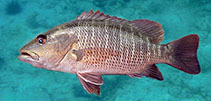| Family: |
Lutjanidae (Snappers), subfamily: Lutjaninae |
| Max. size: |
150 cm TL (male/unsexed); max.weight: 8,700.0 g; max. reported age: 31 years |
| Environment: |
reef-associated; freshwater; brackish; marine; depth range 1 - 120 m, oceanodromous |
| Distribution: |
Indo-West Pacific: East Africa to Samoa and the Line Islands, north to the Ryukyu Islands, south to Australia. Has dispersed into the eastern Mediterranean (off Lebanon) via the Suez Canal but not well established there. |
| Diagnosis: |
Dorsal spines (total): 10-10; Dorsal soft rays (total): 13-14; Anal spines: 3-3; Anal soft rays: 8-8. This species is distinguished by the following characters: body moderately deep, greatest depth 2.3 - 2.7 in SL; preopercular notch poorly developed; vomerine tooth patch crescentic; gill rakers of first gill arch 6-8 + 9-12 = 16-20 (including rudiments); scale rows on back more or less parallel to lateral line, or parallel below spinous part of dorsal fin and sometimes rising obliquely posteriorly, or rarely with entirely oblique rows. Colour of the body generally greenish brown on back, grading to reddish; belly silvery or whitish (deep water specimens usually overall reddish); juveniles with a series of about 8 white and streaks 2 blue across cheeks (Ref. 9821, 90102). |
| Biology: |
A euryhaline species (Ref. 12743). Juveniles and young adults occur in mangrove estuaries, the lower reaches of freshwater streams (Ref. 30573, 48635, 44894) and tidal creeks (Ref. 44894). Adults are often found in groups around coral reefs (Ref. 9710). Eventually migrate offshore to deeper reef areas, sometimes penetrating to depths in excess of 100 m. Mainly nocturnal, this species feeds mostly on fishes and crustaceans. Excellent food fish (Ref. 5484, 44894). An important market species throughout the Indo-Pacific region, but never found in large quantities. A good aquaculture species because it doesn’t get rancid easily when frozen (Ref. 47992). It commands a good export market price with no limit on body size (Ref. 47992). No reported damaging diseases (Ref. 47992). Found in Hong Kong live fish markets (Ref. 27253). Caught mainly with handlines, bottom longlines, and trawls; marketed mostly fresh and dried-salted (Ref. 9821). Maximum length is 104 cm, max weight 14.5 kg and max age 39 years for specimens from the east coast of Australia (pers. comm., Andrew McDougall, 2007). |
| IUCN Red List Status: |
Least Concern (LC); Date assessed: 04 March 2015 Ref. (130435)
|
| Threat to humans: |
reports of ciguatera poisoning |
Source and more info: www.fishbase.org. For personal, classroom, and other internal use only. Not for publication.

